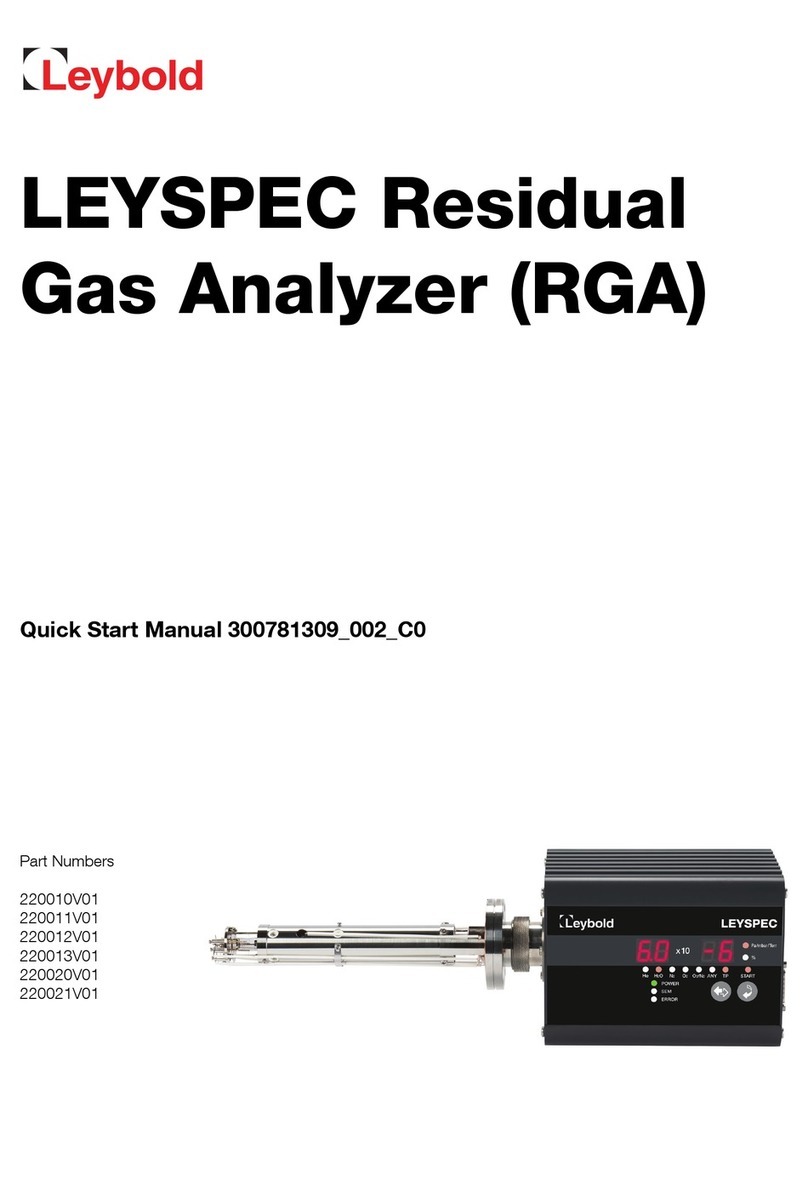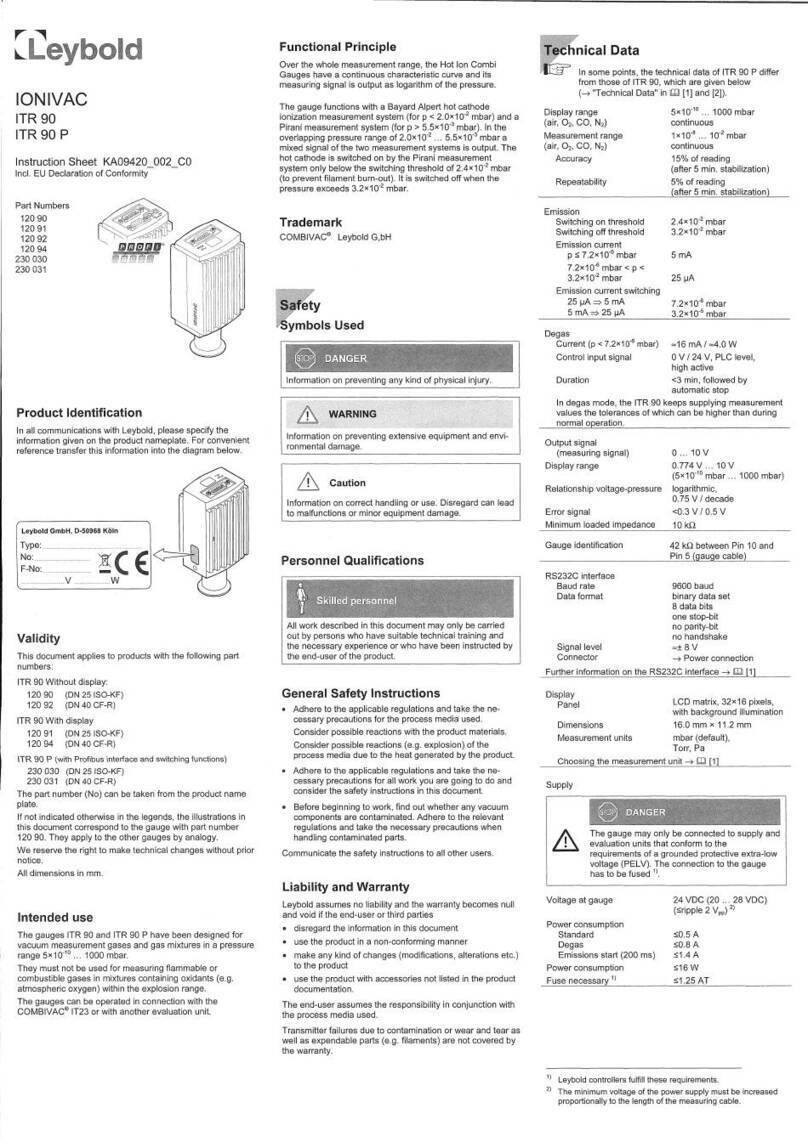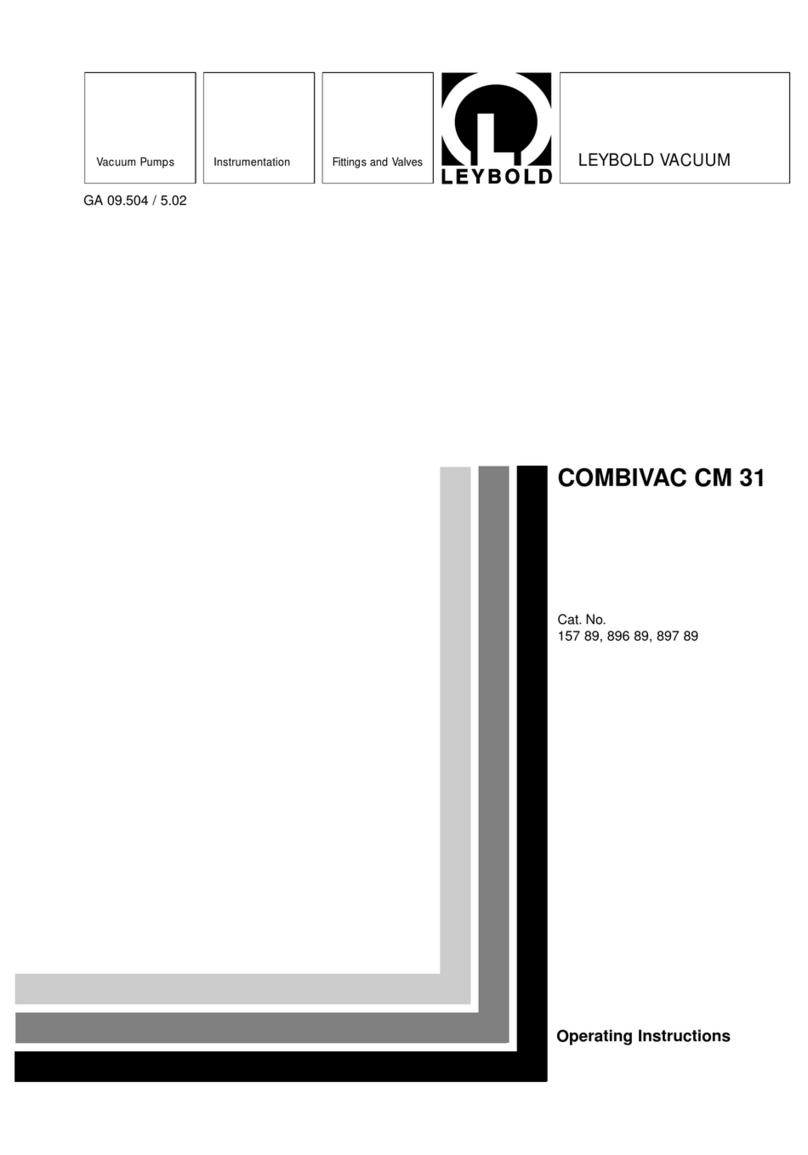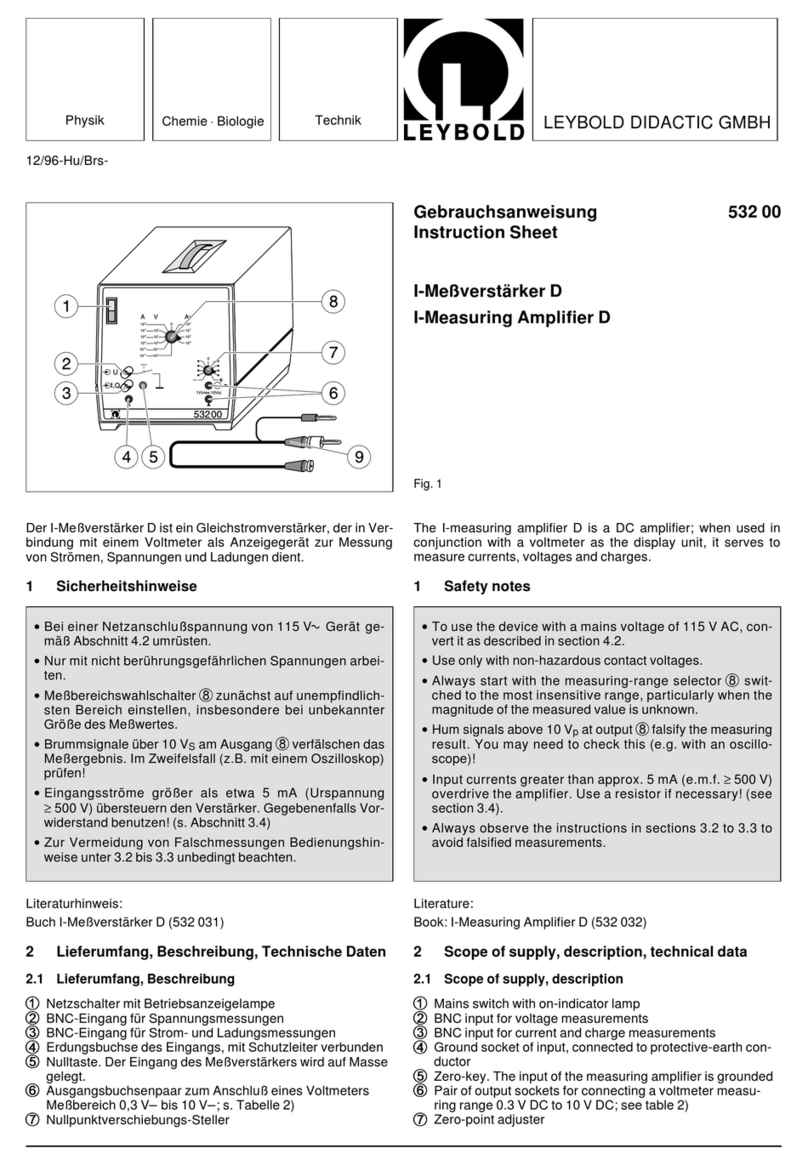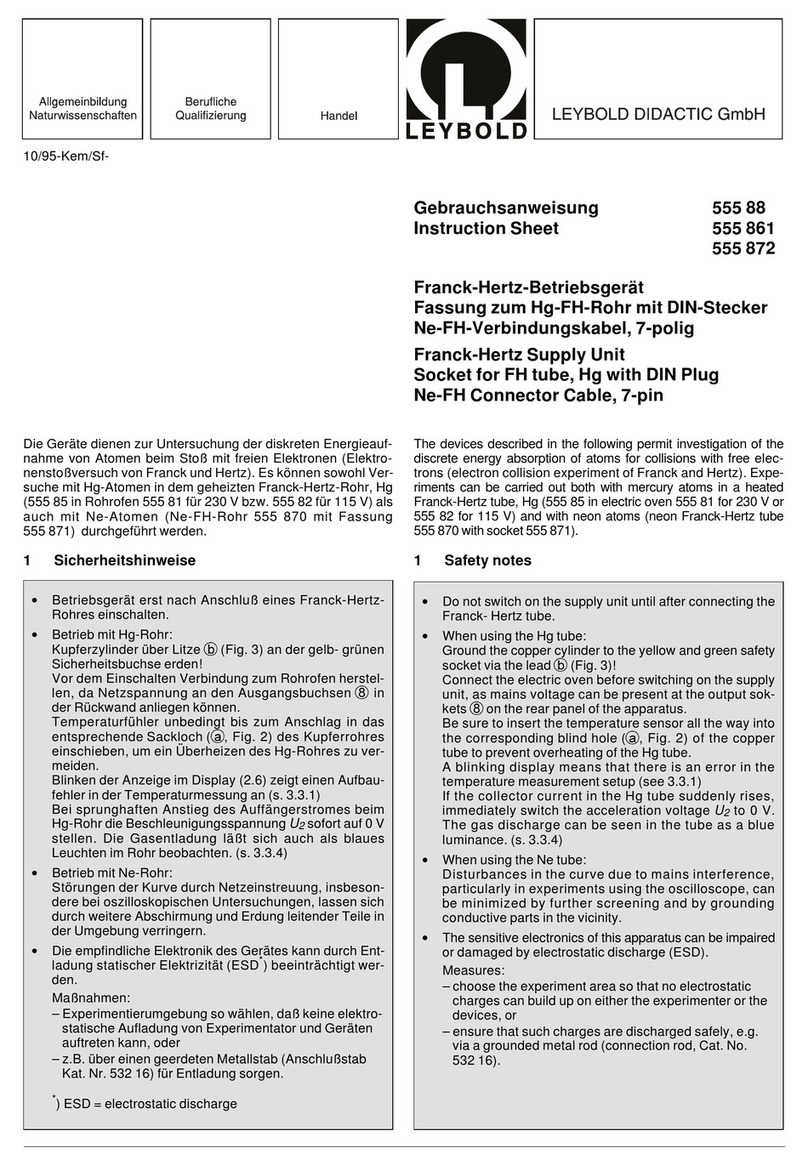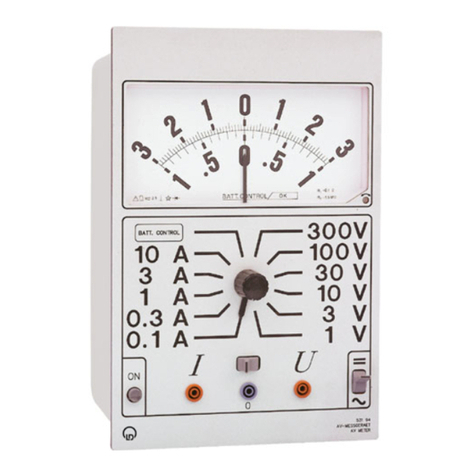
Vorbereitung zur Nullpunktjustierung:
Drehwaage mit Lichtzeigeranordnung z. B. entsprechend Ab-
schnitt 3.3 (bzw. nach den entsprechenden Angaben in der Ge-
brauchsanweisung 332 11), jedoch ohne große Bleikugeln, auf
einem Tisch aufbauen.
Torsionspendel durch Lösen von Schraube
7
(siehe Fig. 2)
entarretieren;
Drehwaage über die Stellschrauben am Stativfuß (bzw. an der
Optischen Bank) so ausrichten, daß das Torsionspendel lot-
recht hängt (Kontrolle: Stift am Pendelende hängt in der Achse
der Bohrung)
Anordnung nach diesen Vorbereitungen etwa 1 Tag erschütte-
rungsfrei "aushängen" lassen, und dann die Nullpunktjustie-
rung vornehmen.
Nullpunktjustierung:
Torsionspendel mit Schraube
7
arretieren und Drehwaage am
Experimentierort aufbauen (z.B. Wandmontage gemäß Fig. 3).
Durch Entarretieren in Schwingungen versetzen.
Die beidseitigen Endausschläge des Lichtzeigers auf der Skala
notieren.
Beobachten, zu welcher Ruhelage das System tendiert;
zur Verkürzung der Beobachtungszeit Schwingungen diama-
gnetisch dämpfen: Wenn sich eine der Bleikugeln des Pendel-
körpers der Glasabdeckung nähert, einen starken Magneten
bis zur Umkehr des Systems dagegenhalten, ohne das Glas zu
berühren.
Falls der Lichtzeiger nicht in eine Ruhelage tendiert, dieetwa in
der Mitte zwischen den beiden notierten Umkehrpunkten liegt,
Torsionskopf
3
nach dem Lösen von Rändelschrauben (3.1)
um einen kleinen Winkel in Richtung des "Soll-Nullpunktes"
drehen.
Erneut die beiden Endausschläge sowie die Nullpunkttendenz
des Lichtzeigers beobachten.
Die Nullpunktjustierung fortsetzen, bis der "Soll-Nullpunkt" in
der Mitte zwischen den beiden Umkehrpunkten des Lichtzei-
gers erreicht ist.
4 Austausch des Torsionsbandes
Ein defektes Torsionsband kann gegen ein neues Band ausge-
tauscht werden, das als Ersatzteil (683 21) montagegerecht
geliefert wird.
Der Austausch wird folgendermaßen durchgeführt:
Vorbereitung
- Drehwaage (mit arretiertem Pendelkörper) so in einem nivel-
lierbaren Stativfuß (z. B. 300 01/06) aufbauen, daß sich die
Rückseite vorne befindet; Schutzrohr mit Ersatz-Torsions-
band (683 21) zur sicheren Handhabung in einer Klemme
haltern (Fig. 8.1).
- Schraube (a1) entfernen; danach die anderen Schrauben,
welche die Glasplatte fixieren, lockern, bis die Platte entfernt
werden kann (Fig. 8.2).
- Glasscheibe (a2) und Abdeckung (a3) entfernen sowie den
vorderen Teil (a4) der Blende herausziehen.
Ausbau des defekten Torsionsbandes
- Schraube (c1) (Fig. 8.4) und - bei festgehaltenem Bandhalter
(b) - Madenschraube (b1) lösen und Bandhalter entnehmen
(Fig. 8.3).
- Bei gerissenem Torsionsband Endstück (c) entfernen (Fig. 8.4).
Einbau des neuen Torsionsbandes
- Schraube x1lösen und bei festgehaltenem Bandhalter (B)
Schraube x2entfernen (Fig. 8.5).
- Anordnung mit großer Vorsicht und ohne Wandberührung
des sehr empfindlichen Torsionsbandes aus der Schutzhülle
nehmen und in die Drehwaage fädeln, bis das Endstück (C)
1 mm bis 2 mm über der Bohrung (c2) hängt; sodann Band-
halter (B) durch Anziehen von Schraube (b1) fixieren
(Fig. 8.6).
Preparation for zero-point adjustment:
Assemble the torsion balance with light pointer arrangement on
the lab bench e.g. as described in section 3.3 (or in accord-
ance with the corresponding information in the Instruction
Sheet 332 11), but without the large lead balls.
Unlock the torsion pendulum by loosening the screws
7
(see
Fig. 2).
Using the levelling screws on the stand base (or on the optical
bench), align the torsion balance so that the torsion pendulum
hangs vertically (check: pin at the end of the pendulum hangs in
the axis of the hole).
After these preparatory steps have been carried out, allow the
arrangement to hang disturbance-free for around 1 day and
then carry out the zero-point adjustment.
Zero-point adjustment:
Lock the torsion pendulum with screw
7
and set up the torsion
balance at the experiment location (e.g. wall mounting as
shown in Fig. 3); then unlock the pendulum to set it in motion.
Note the end deflections of the light pointer on both sides of the
scale.
Observe the equilibrium position towhich the system tends;
to shorten the observation time damp the oscillations dia-
magnetically: each time one of the pendulum lead balls
approaches the glass cover, use a strong magnet to reverse
the motion of the system - without touching the glass.
Should the light pointer not show a tendency towards an
equilibrium position roughly in the center between the two noted
direction reversal points, unscrew the knurled screws (3.1) and
turn the torsion head
3
through a small angle in the direction of
the "desired zero-point".
Once again observe the two end deflections and the zero-point
tendency of the light pointer.
Continue this zero-point adjustment until the "desired zero-point"
in the middle between the two direction reversal points of the
light pointer has been reached.
4 Replacing the torsion band
A defective torsion band can be replaced by a new band which
is supplied in a ready-for-assembly state as spare part (683 21).
The replacement is carried out as follows:
Preparation
- Assemble the torsion balance (with locked pendulum body)
on a stand base which can be levelled (e.g. 300 01/06) in
such a way that the back side is at the front; to ensure safe
handling, support the protective tube with replacement torsion
band (683 21) in a clamp (Fig. 7).
- Remove screw (a1); subsequently loosen the other screws
fixing the glass plate until it can be removed (Fig. 8.2).
- Remove glass plate (a2) and cardboard seal (a3) and pull out
the frontsection of the cardboard slide (a4).
Removing the defective torsion band
- Loosen grub screw (b1) while holding the band holder (b)
tightly. Remove the band holder (Fig. 8.3).
- If the torsion band is broken, remove end piece (c) (Fig. 8.4).
Inserting the new torsion band
- Loosen screw x1and remove screw x2while holding band
holder (B) tightly.
- Very carefully remove the arrangement from the protective
cover and "thread" it into the torsion balance until the end
piece (C) hangs 1 mm to 2 mm above the hole (c2). Make
sure the very sensitive torsion band does not come into con-
tact with the walls. Subsequently fix pendulum holder (B) by
tightening screw ((b1) (Fig. 8.6).
- Wait until the torsion band has settled and, if necessary, use
the levelling screws on the stand base to align the torsion
band so that the end piece (C) hangs vertically above the
hole.
7
